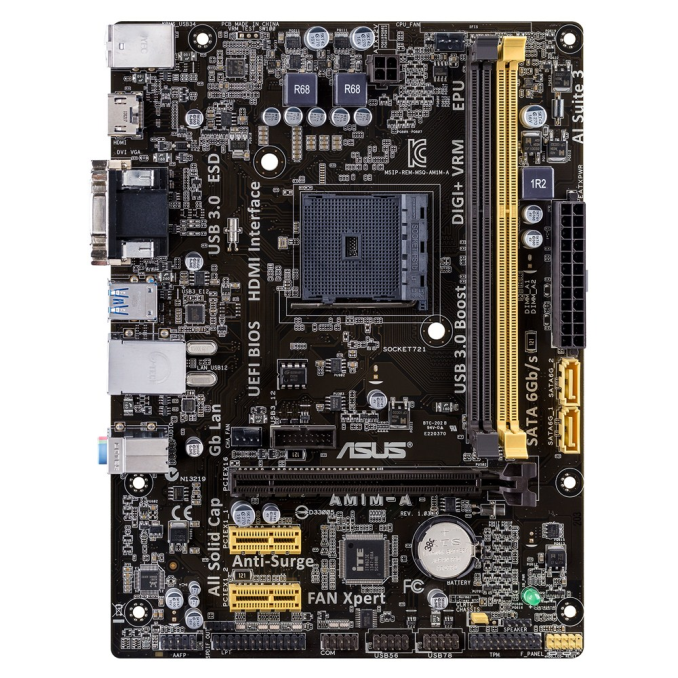The AM1 Kabini Motherboard Preview: Analyzing the Hardware
by Ian Cutress on April 19, 2014 2:00 PM ESTASUS AM1M-A
The first ASUS motherboard into the mix comes in at a hefty $47, or 42% more than the first Biostar motherboard in this preview. This takes the minimum entry of a quad core socket system to $82 where we are starting to encroach on the low end AMD FM2 systems. Despite the price point ASUS attempts to come out with all guns blazing, so to speak. It starts with the aesthetics, where ASUS is matching their gold/mustard yellow color from their Z87 and A88X chipsets.
The major plus point on the AM1M-A is the additional USB 3.0 controller, providing two USB 3.0 ports on the back panel and leaving the two from the chipset as an onboard header. This comes alongside using four USB 2.0 ports on the rear rather than two. The network and audio combination is Realtek, however the audio is the higher rated ALC887 codec.
ASUS is keen to point out their use of enhanced OCP and higher quality solid caps, though in terms of pure functionality it seems that some of the other motherboards might be ahead. The BIOS and software should be ASUS standard, and as noted on the board features such as Fan Xpert for the two 4-pin headers.
The rear panel, due to the extra USB 2.0 ports on the rear, reduces the PS/2 connectors down to one. We also have HDMI and DVI-D to complement the VGA port.
| ASUS AM1M-A | |
| Price | Link |
| Size | Micro-ATX |
| CPU Interface | FS1b |
| Chipset | Kabini |
| Memory Slots |
Two DDR3 DRAM slots, supporing 32GB Single Channel, 1333-1866 MHz |
| Video Outputs |
VGA (1920x1200 at 60 Hz) DVI-D (1920x1200 at 60 Hz) HDMI (4096x2160 at 24 Hz or 1920x1080 at 60 Hz) |
| Onboard LAN | Realtek 8111GR |
| Onboard Audio | Realtek ALC887 |
| Expansion Slots |
1 x PCIe 2.0 x16 (x4) 2 x PCIe 2.0 x1 |
| Onboard SATA/RAID | 2 x SATA 6 Gbps |
| USB 3.0 |
2 x USB 3.0 (Chipset) [header] 2 x USB 3.0 (ASMedia ASM1042) [back panel] |
| Onboard |
2 x SATA 6 Gbps 1 x USB 3.0 Header 2 x USB 2.0 Headers 2 x Fan Headers 1 x TPM Header 1 x COM Header 1 x LPT Header 1 x S/PDIF Output Header Front Audio Header Front Panel Header |
| Power Connectors |
1 x 24-pin ATX 1 x 4-pin CPU |
| Fan Headers |
1 x CPU (4-pin) 1 x CHA (4-pin) |
| IO Panel |
1 x Combination PS/2 Port VGA DVI-D HDMI 2 x USB 3.0 (ASMedia) 4 x USB 2.0 1 x Gigabit Ethernet Audio Jacks (ALC887) |
| Product Page | Link |
ASUS, like some of the others, use both the main legacy connectors as headers (COM, LPT) with a TPM header.













64 Comments
View All Comments
rRansom - Sunday, April 20, 2014 - link
Test acknowledged.Samus - Monday, April 21, 2014 - link
I got it too.Ortanon - Monday, April 21, 2014 - link
lollmcd - Saturday, April 19, 2014 - link
The MSI would do better to have antenna and an attach point for everything for 2-3 $ more.lmcd - Saturday, April 19, 2014 - link
The commentary on the ASRock AM1H-ITX price misses the mark -- the benefits of the DC laptop power option mean that a tiny case attached to a VESA mount can be more easily used. Also, aren't such power supplies cheaper?teldar - Monday, April 21, 2014 - link
I built one with the a asrock am1h and didn't even use a case. It's screwed to a piece of lexan and th e ssd is stuck underneath it.MonkeyPaw - Saturday, April 19, 2014 - link
I would love to see some tests with GPUs installed. Since the jaguar core is also used in the latest consoles, I'm curious to see what happens when you drop comparable GPUs (to the new consoles) inside. Can the PS4/XboxOne even make good use of all that GPU power with such a basic CPU? Do it for science!wolrah - Saturday, April 19, 2014 - link
A tricky difference with the consoles is that they get twice the cores compared to retail offerings.tuxRoller - Saturday, April 19, 2014 - link
http://www.phoronix.com/vr.php?view=20215You're welcome:)
MonkeyPaw - Saturday, April 19, 2014 - link
I saw that, but it's on Ubuntu, which isn't quite up to speed as Windows.Also, while I know the new consoles have 8 cores, they run at lower clocks than the 5350. I also have my doubts that most games can use all 8 cores effectively. I think they are there more for better multitasking. Like I said, it would be interesting to see what a mid-range GPU could do here. Would it be worth it to spend $80 on AM1 and $150 on a GPU, or would that $230 go further another way, like with an A10-7850K? Which would make a better budget gaming combo? You might also be able to skimp on RAM with AM1 since you'll have a dedicated GPU will